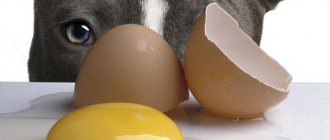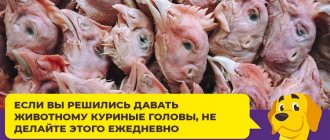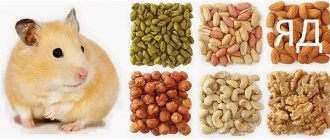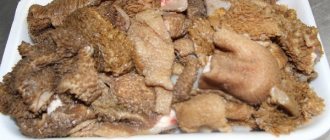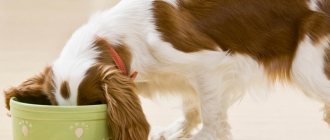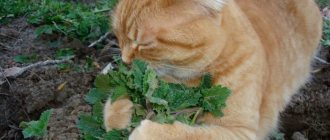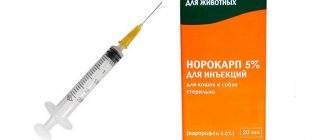Dog breeders are often concerned about the balanced nutrition of their pets, because four-legged pets cannot feed themselves. There are heated and endless debates about the safety of feeding animals with fresh and boiled vegetables.
ordinary white cabbage causes doubts and fear ! Let's try to figure out whether this vegetable is really necessary and how true are the fears of careful owners who guard the health of their charges.
Animal's need for vegetables
To understand a domestic animal, you need to remember its distant ancestors: wolves, jackals and foxes. “Relatives” living in nature eat meat in the event of a good hunt. Typically, predators feed on plants, eggs, small rodents, amphibians and insects.
Pasture includes fruits, berries, roots, algae, herbs, bark and even mushrooms . This indicates a genetically inherent need for plant foods in the daily diet of a four-legged friend.
Give with caution
The consumption of vegetables from this group should be limited, but not completely eliminated. This is due to the possible risk of allergic and other adverse reactions. Monitor your pet's condition after consuming these products. It is possible that your dog tolerates them well and there is no cause for concern.
Tomatoes
Tomatoes should be given with caution due to the fact that their green part contains solanine, a toxin that can cause poisoning. A ripe red tomato is a completely safe product. Tomatoes contain a lot of calcium and magnesium, as well as vitamin B. Therefore, it is not necessary to completely exclude them from the diet.
Beet
The main danger when eating beets is diarrhea. Fresh vegetables have a laxative effect, so it is better to feed your pet baked beets. In addition, some dogs have an allergic reaction to eating beets. The benefits of its use include its high calcium content.
We recommend this article:
By-products for feeding dogs - are they good for your pet?
Broccoli
Large quantities of broccoli should not be given to dogs as it can be fatal. Broccoli contains a poison that is dangerous to animals - isocyanate. However, it is worth noting that in order to be poisoned, a dog must eat more than a kilogram of cabbage. In small quantities, this vegetable is healthy; it contains a lot of vitamins A, C and K.
Asparagus
Asparagus is not dangerous for the animal, but its consumption does not bring any benefit. It is easily digestible, but the amount of vitamins and minerals in boiled form is minimal.
We recommend this article:
What cereals can be given to dogs and what should not be fed?
White cabbage
IMPORTANT! A healthy, active dog, not restricted in its diet by a veterinarian, can and should eat cabbage!
The main part of the menu of a domesticated predator consists of 70-80% products rich in animal protein. Vegetables and grains saturated with natural vitamins and microelements occupy the remaining, but no less important place .
Benefit
Cabbage contains natural antioxidants, vitamins and fiber necessary for digestion, is a source of calcium, sulfur, potassium, phosphorus, beta-carotene and vitamins A, B and C, prevents the development of cancer and improves the condition of the skin and coat.
Dog owners tell how their pets enjoy eating cabbage . There is information that many dogs like to gnaw on heads of cabbage, hard parts of leaves, and play with stalks. After such a feast, undigested pieces appear in the feces of the mischievous people. No need to worry about this.
Vegetative food is poorly absorbed by the dog's body. Their digestive system lacks enzymes involved in the breakdown of cellulose. Question: why feed an animal something it cannot digest?
The content of cabbage in your pet’s diet is very important! The affordable vegetable is rich in vitamins and microelements, so necessary for a living creature, and takes an active part in digestion.
Why is a plant-based diet so important?
Carnivores are not able to extract energy from complex carbohydrates - this is a feature of herbivores . Coarse fiber from raw vegetables and bran is a nutrient medium for the development and formation of healthy microflora, stimulates the functioning of the predator’s intestines and removes excess cholesterol.
Cabbage is a source of slow carbohydrates and dietary fiber, which create healthy microflora and help the animal digest meat.
IMPORTANT! Excluding vegetables from the diet leads to a decrease in the number of beneficial bacteria in the microenvironment of the gastrointestinal tract and their replacement by pathogenic colonies of E. coli and yeast, which cause dysbacteriosis.
Beijing
The taste of this cabbage variety remains tender and fresh throughout the year. Pekingese dishes are rich in flavor, which is why dogs of all breeds like them.
The vegetable is rich in amino acids, magnesium, calcium, and the juice has pronounced bactericidal properties. Low fiber content helps avoid flatulence and increased stress on the gastrointestinal tract.
How often and in what quantities?
But you shouldn’t fanatically put your animal on a plant-based diet. After introducing your pet to this garden gift, it should be introduced into the diet gradually and in small portions . If you like the treat, then it should be consumed fresh periodically and in small quantities.
According to breeders, among their four-legged friends there are real gourmets who love to eat cabbage raw. There is no need to deprive such a dog of the desired treat - the body signals a lack of vitamins . You just have to limit your tummy from overeating, which applies to any product, even a very healthy one.
Harm and allergies
Despite all the usefulness of cucumbers, you should not feed them to animals uncontrollably. In large quantities they can cause diarrhea.
Allergies to cucumbers are practically not common in dogs. However, vegetables purchased from the supermarket can negatively affect the health of the animal.
Rashes on the face, paws, ears, loss of appetite, vomiting and lethargy are signs that your pet has been poisoned by cucumber, or more precisely, by the nitrates contained in the untested product.
To avoid trouble, it is advisable to feed the animal cucumbers that you grow yourself. If this is not possible, the product must be thoroughly washed and peeled.
Early, greenhouse cucumbers are especially dangerous in this regard - to speed up their ripening, unscrupulous farmers generously use fertilizers. It is highly undesirable to offer them to an animal.
Is there any harm?
Fresh cabbage eaten in large quantities can negatively affect your health . Usually the glutton ends up with gas formation, seething in the belly, bloating and strong winds. Sometimes this is accompanied by discomfort in the intestines.
Dogs suffering from diseases of the gastrointestinal tract and thyroid gland should be given cabbage according to the recommendation of a doctor, in doses, after appropriate treatment. The owner must remember that even in small quantities the plant contains a natural component called thiocyanate , which in large doses suppresses the thyroid gland and leads to hypothyroidism.
If a dog cannot imagine life without a tasty treat and wants to eat it often and a lot, then it is better to boil the vegetable before consumption in order to neutralize the unwanted substance.
Reasons why you can't
Cases of individual intolerance to white cabbage in dogs are quite rare. Small species are characterized by difficult digestion of plant foods and difficult gas separation. In this case, the cabbage should be steamed, stewed, boiled and served in small portions .
Attention to the animal's diet is required for certain forms of diseases and allergies. Typically, such pets are under medical supervision and strict dietary control.
ATTENTION! Add new products gradually, observing the dog's reaction.
What to do if your pet has eaten too much and feels bad?
In case of overeating, and such cases are unique and isolated, some symptoms may occur :
- Difficulty in digestion caused by excessive consumption of food;
- Excessive gas formation, accompanied by bloating and pain in the intestines;
- The animal is inactive, lies for a long time, stretches unnaturally, whines;
- He does not allow himself to be examined due to pain in the peritoneal area.
The owner should contact a veterinarian, not self-medicate and not give any medications , blurring the overall picture of the condition. At the appointment, describe in detail the dog’s behavior from the moment the illness began, trying to indicate as accurately as possible the time and cause of the deterioration in health.
Restrictions and contraindications
Cabbage is contraindicated for animals with hormonal imbalances in the body. It contains the substance thiocyanate, which suppresses the activity of the thyroid gland. The vegetable is not added to the diet of dogs suffering from diseases of the digestive system, as it increases unpleasant and painful symptoms.
You should not give sauerkraut to dogs. This type of nutrition causes stomach turmoil, bloating, and flatulence. The dog can get beneficial live bacteria that appear when vegetables are fermented from fermented milk drinks and safe food additives.
Remember, super premium food already contains all the necessary vitamins and microelements. Canned food for dogs, unlike stew, is also enriched with a vitamin and mineral complex. Therefore, with such feeding, there is no need to give vegetables.
Puppies, pregnant or lactating
Feeding a mother before and after childbirth depends entirely on her appetite, her condition and food preferences. Usually it is milk porridge and meat puree with vegetables.
Boiled or stewed cabbage with meat is an important component in the presence of calcium, vitamin C and other necessary elements. You can forget about the vegetable in its raw form, because babies get absolutely everything that their mother eats, and excess gas formation is extremely undesirable for her, either “before” or “after”.
Attention! It is important to accustom animals to natural feeding in a timely manner. After getting acquainted with milk, cereals and meat supplements, vegetable soup appears on the children's menu, to which a pinch of finely chopped raw cabbage is added with boiled cereals and finely chopped steamed meat.
Puppy meal options:
- vegetable soups;
- porridge in vegetable broth with meat and cabbage;
- separately cooked meat with vegetables.
Chop or finely grate all plant foods, add a little butter or sour cream.
An irreplaceable vitamin supplement in the form of a mixture is also served as an independent dish. When the puppies grow up and get stronger, the diet includes a salad of fresh vegetables with vegetable oil.
Principles for introducing vegetables into a dog's diet
Fiber should be introduced into your pet's diet with caution. To avoid allergic reactions and indigestion, follow certain rules:
- First, they give a little bit of safe, non-allergenic foods. After a few days, after seeing the body’s reaction, the dog’s diet can be diversified with other types of vegetables.
- The share of meat in the daily feeding rate should be 70-80%, the rest should be supplemented with vegetables and grains.
- You cannot give a mixture of different crops. Add one type at a time. If the dog’s body reacted normally, you can try with another product.
- There is no need to feed the animal sweet fruits and vegetables of exotic origin. The dog's body, like the human body, is less allergenic to products grown in its region of life.
- During the first feedings, dogs are given boiled vegetables.
There is no need to introduce your dog to vegetables by offering crops with a strong smell. Animals are wary of fragrant celery, dill, and parsley.
On a note! Vegetables are gradually introduced into the dog’s diet, starting with boiled root vegetables.
Bowl with mixed meat and vegetable food
Raw, boiled, stewed or pickled?
Precisely because a dog is not able to completely digest cabbage, this product, as the main source of fiber, is involved in the processes of feces formation, intestinal motility and maintaining favorable microflora. Question: in what form should I give it?
It makes no difference how you offer vegetables - finely chop them or puree them. The main thing is to focus on health characteristics, veterinarian advice, the preferences of the dog, the state of the digestive system and teeth.
For better absorption of vitamins, the product is crushed or ground. Can be boiled or boiled by adding other ingredients.
Feed alternation
- grind in a blender;
- grate;
- cut in small pieces;
- cut into cubes or cubes;
The dog happily eats diced vegetables, independently chopping them to a size that is convenient for him.
Chewing raw cabbage helps prevent plaque formation and freshens breath .
This form of feeding is not suitable for puppies and adult pets transitioning to natural nutrition from dry food. Children are not able to chew food, and the animal, not accustomed to innovations, chooses meat, leaving pieces of vegetables untouched.
Vegetables can be given raw, boiled or baked . Many of them contain beta-carotene, which is digestible only when stewed with a small amount of animal fat, sour cream or kefir. These include: carrots, cabbage, tomatoes, eggplants, turnips and beets.
TIP: Does your dog enjoy fresh cabbage with pleasure and without consequences? To preserve valuable properties, there is no need to heat treat the product.
If desired and possible, you can pamper your little animal with a delicious vegetable casserole :
Ingredients vary according to pet's preferences:
- carrot;
- pumpkin;
- zucchini;
- cabbage;
- tomato;
- a raw egg;
- cheese;
- sour cream, kefir;
- vegetable oil.
Cooking method:
- Grease the mold with vegetable oil;
- Peel vegetables from hard skins;
- Cut the products into cubes;
- Add the egg and sour cream, then mix everything;
- Sprinkle grated cheese on top and mix again;
- Pour kefir into this mass and mix;
- Place in a preheated oven at 190 C for 15-20 minutes.
You can also give your dog vegetable stew with cabbage . When preparing such dishes, you need to take into account the animal’s taste preferences. There are dogs who don’t eat this green product at all, others love it stewed. If the animal shows a negative attitude towards an unfamiliar thing, then it is better to create a combination with meat.
Accustoming to a new food is to mix vegetables into the minced meat, bringing it from a minimum to normal. If you categorically refuse plants, bran can be an alternative.
It is important to give a few tablespoons of sauerkraut, rich in ascorbic acid, 2-3 times a week.
ATTENTION! Under no circumstances should your dog eat any fried food!
Useful
However, not all vegetables are created equal for dogs. And it is often unclear what foods are best to feed your pet. They can be divided into 3 categories: useful, relatively useful and dangerous. What vegetables are good for dogs? Let's find out.
Cabbage
There is a lot of controversy about whether cabbage can be given to dogs. And completely in vain! Cabbage belongs to the category of healthy vegetables. You can eat different types of it, most often animals are given white and colored ones.
Cabbage has an antioxidant effect, contains vitamin C, and is a source of fiber. White cabbage is best consumed boiled.
Cauliflower is indicated even for pathologies of the gastrointestinal tract, since it does not damage the intestinal mucosa.
Celery
It is also recommended to add celery to your pet's diet. It is a source of potassium, magnesium, vitamins A and C. Celery has a positive effect on the cardiovascular system. However, it has a specific taste and smell, so animals often refuse such a product. In this regard, it is better to give celery baked, as it is better tolerated by animals.
We recommend this article:
What bones can be given to dogs and is it worth it?
Carrot
One of our favorite foods is carrots, an essential source of vitamin A. They can be given either raw or boiled. It is recommended to mix carrots with sour cream or vegetable oil. This way, fat-soluble vitamins are better absorbed.
cucumbers
You can safely give cucumbers to dogs. They do not contain coarse fiber and are easy to digest. There are no contraindications to them.
bell pepper
Another product that will benefit your pet is bell pepper. It contains many trace elements (potassium, magnesium, zinc) and B vitamins. Pepper can be given either baked or raw.
Turnip
Veterinarians also classify turnips as useful. It contains a lot of calcium and also has a mild anti-inflammatory and diuretic effect. However, it is not recommended to consume turnips for diseases of the digestive tract.
Pumpkin
Pumpkin can become a favorite treat for dogs. This is not only tasty, but also a healthy product. Moreover, it is absolutely safe. Pumpkin has a beneficial effect on the gastrointestinal tract and also helps fight helminths.
We recommend this article:
Why dogs can’t have sweets and is this really true?
Is it possible to feed a colored one?
Many are afraid of this vegetable, and in vain! This variety is much better than others, but it should be steamed, stewed or boiled. The lower content of coarse fiber does not irritate the gastric mucosa and the product is easily digested. This cabbage increases the secretion of bile and promotes regular bowel movements, which is recommended for gastrointestinal diseases, liver and gallbladder diseases.
Cauliflower is a storehouse of vitamins and minerals. Contains: C, K, PP, B2, and also: potassium, calcium, magnesium, phosphorus.
It has anti-inflammatory properties and prevents obesity. These properties are important for older dogs with musculoskeletal problems and immobility. But we must, as always, observe moderation.
Harm
Like any product, carrots in excessive quantities will harm the dog’s body. Do not forget that the acceptable percentage of vegetables in the diet of an adult animal is from 5 to 30%.
The most significant harm that is possible when a dog eats carrots is an exacerbation of peptic ulcers. Therefore, animals with this problem, as well as older ones, should be treated with vegetables with caution.
Occasionally, when eating carrots, diarrhea is observed, but if you get carried away with boiled carrots, the dog will suffer from constipation. If carrots are actively included in the diet, the dog’s feces will turn a reddish color, but you should not be afraid of this.
Another, more significant problem is that the high carotene content in the vegetable can change the dog’s color. White breeds develop yellowness in their coat, which is worth considering if your pet is being prepared for an exhibition.
However, carrots are not recommended for white dogs anyway: the risk of allergies is high.
Allergy
Food allergies to carrots occur frequently in animals. It is impossible to predict whether a particular animal has it, you will have to try.
If allergy symptoms appear, you should consult a veterinarian: it often occurs not to the vegetable itself, but to the substances with which the carrots were processed. Therefore, the chance of getting an allergic reaction to homemade carrots or premium food with its addition is lower than to store-bought ones.
What can you feed your Yorkie?
Both natural and dry foods are suitable for this breed (such as Acana Classics dog food). It all depends on the owner’s capabilities and desires, and state of health. However, the basis of any dog’s diet should be proteins, which are found mainly in meat. It is also necessary to take care of a sufficient amount of carbohydrates, fiber, vitamins and minerals. How many times a day should you feed your Yorkie? Is it necessary to boil food and is raw food dangerous for contamination?
Simple rules for experienced and novice owners:
- Meat and tripe are given only raw; after heat treatment they lose their beneficial properties. Offal (liver, heart, lungs) is lightly boiled to avoid stomach upset. Scalding will not kill harmful microorganisms, but regular treatment with anthelmintics will save you from parasites.
- For an adult, feeding two or three times a day is sufficient. For newborns, juniors, patients, pregnant women, and the elderly, the frequency is different.
- Access to fresh drinking water is always free for any feeding method.
- A Yorkshire Terrier should not fast for more than 1 day. Hypoglycemia is a dangerous condition and sometimes leads to death; it appears due to a sharp decrease in blood sugar after a long fast. The smaller the dog, the higher the risks.
- Pieces of food should be of medium size (about 22 cm) so that the jaws work and the Yorkie does not choke. Minced meat is very poorly digestible.
- You can't constantly change your diet. A monotonous menu of familiar ingredients with rare inclusions of delicacies is better.
- Do not mix feeding dry and natural products. The digestive system of ornamental breeds rarely copes with sudden transitions and cannot quickly regulate the production of enzymes for each type of food.
- Food is given only warm, as is water. Hot causes burns to the mucous membranes, and cold causes gastritis.
- In winter, the serving volume is 15% larger during long walks and low air temperatures.
Feeding your Yorkie natural food
Feeding a Yorkshire Terrier with natural products does not bring additional hassle, because they need very little. The diet should be based on proteins - about 3.5% of the animal’s weight. For example, if you weigh 3.5 kg, you need 105 g of beef per day. Trip is less nutritious, so the portion with it is increased by 1.5 times. In terms of composition and digestibility, beef and horse meat of the 2nd grade with streaks are ideal. Chicken and turkey are easily digestible, but frequent consumption can lead to excess protein and allergies, liver damage. Give them 2-4 times a week. Chicken eggs are healthy and nutritious; they are boiled and only the yolk is fed to the pet 3 times every 7 days. Quails in the amount of 2 pieces are given in the shell and raw. They do not carry the dangerous disease salmonellosis.
Cottage cheese, kefir, fermented baked milk, whey and yogurt saturate the body with protein, calcium and support the microflora of the digestive system, so they are always present in the diet. You can eat them every other day. Only sea fish without a ridge, boiled for 10 minutes, are acceptable: pink salmon, hake, halibut, cod, small mackerel, salmon. There are a lot of parasites and small bones in the river, it needs to be boiled for a long time and it becomes useless and falls apart.
Fruits (green apples), herbs (parsley and dill), vegetables (zucchini, pumpkin, cucumbers, carrots) are a source of vitamins and minerals, fiber. Finely cut, stewed in water for 5 minutes, and added to regular food. Porridge - carbohydrates and vitamin reserves, rice and buckwheat are boiled until soft and 1 tablespoon is placed in a bowl. In summer, you can avoid grains. Useful additions to natural food: salt and vegetable oil. Suitable delicacies include a lightly salted piece of cheese, a large beef bone, which is selected before the pieces are cut, a chicken carcass, cartilage, sinews, pig ears, and beef hooves. A small pet will not eat them, but will wear off plaque on the teeth and exercise its chewing muscles.
This is what a sample daily menu looks like for a healthy Yorkie over a year old and weighing 3 kg:
- meat trimmings - 105 g;
- cereals - 1 tablespoon;
- sour milk - 50 g;
- fish - 150 g;
- salt - 2-3 g;
Feeding your Yorkie with dry food
For Yorkies, choose premium and super-premium dry food. The minimum protein content in them is 20%, the maximum is 60%, the average percentage of fat is 18%. They can consist of meat from various animals, meat and bone meal, herbal extracts, fruits, and be grain or grain-free. For individuals with weak stomachs, croquettes with prebiotics have been created to maintain and restore beneficial microflora. The balls in any package should be tiny so that your Yorkie can easily chew them. You should be careful about ready-made food with vitamin and mineral supplements, and consult your veterinarian before consuming it. In any case, more water is consumed, the liquid prevents the formation of kidney stones.
They proceed to drying slowly in 15-20 days. Initially, add 1 ball to the bowl; you can soak it with warm water or low-fat kefir. Next, the number of croquettes is increased until they are left alone without natural products. During the reverse transition, natural ingredients are also included gradually. A sudden change is fraught with disruption of the gastrointestinal tract and a long return to normal. In some lines and nurseries, several generations of Yorkies eat only pellets, and their descendants have difficulty digesting beef trimmings and steamed cuts.
Helped you learn a little more about the Yorkshire Terrier breed? Read our other articles on the website: Education and training of the Yorkshire Terrier
Manufacturers of dry food for Yorkies
Almost all well-known and large brands have lines marked “for active and small” (from 1 to 10 kg). Too low a cost indicates poor protein content and a lot of useless and sometimes dangerous fillers (corn, cake, fat, ground horns, leather). A high price is also not a guarantee, but due to the characteristics of the individual consumer. The following companies received recognition among owners:
- Acana;
- Purina Pro Plan;
- Grandorf;
- Royal Canin;
- Brit;
- Josera.


